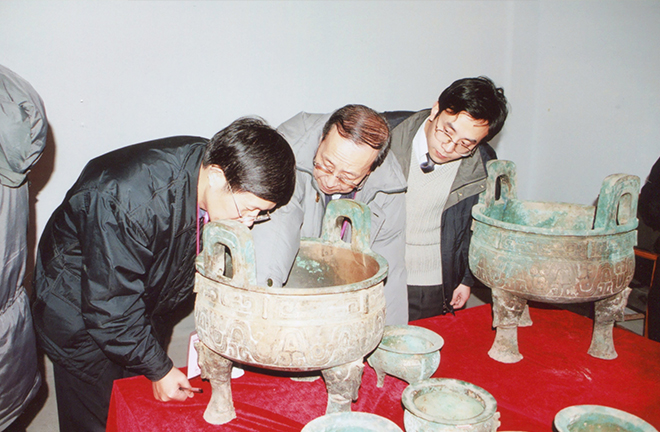In remembrance of Chinese historian Li Xueqin

Li Xueqin (second from right) interpreting the inscriptions inside a Lai Ding vessel from the Western Zhou Dynasty Photo: Courtesy of ZHANG MAORONG
The first time I met Mr. Li Xueqin was on a summer night in 1979 when he came to give a lecture at Northwest University, where I was studying as a student. Li had worked there back in the early 1960s as the assistant to Hou Wailu, the then-president of Northwest University, and was later appointed as a part-time professor. Starting in 1982, Li began recruiting graduate students at Northwest University, and I was fortunate to be among his first cohort of students, studying ancient scripts under his guidance.
During my graduate studies, Li advised me to focus on bronze inscriptions as we were in Shaanxi of the time, a place with numerous ancient bronze artifacts. After graduating, I worked at Northwest University as a teacher. Li often came to the university to give lectures. Outside of class, he enjoyed visiting archaeological sites and museums, particularly observing bronze artifacts. Once, during a casual conversation, he said, “Over the years, I have been doing research on diverse domains, but I still prefer bronzes the most.” Indeed, discussions on bronze artifacts occupy a significant portion of his writings.
The key to studying bronze artifacts and their inscriptions is observing them face-to-face, which requires researchers to have extensive practical knowledge and judgment. Li had an exceptional memory and usually did not need to take notes. Upon seeing a bronze artifact, he could immediately recall similar pieces and detail their names, forms, patterns, and inscriptions. During a visit to the warehouse of Xi’an Cultural Relics Management Committee, he effortlessly read and interpreted a 68-character inscription on the plate of Lyu Fuyu [a Western Zhou bronze plate] as if it were a modern text, much faster than I could, even though I had seen it before.
In 1992, the second academic symposium on Western Zhou history was held in Xi’an. Prior to the conference, the Shaanxi Provincial Institute of Archaeology conducted an excavation at the Haojing site in Chang’an County, Xi’an. A batch of oracle bones inscribed with primitive symbols was discovered among the second-phase Keshengzhuang cultural remains. Certain renowned scholars claimed these were the earliest Chinese characters, calling it “an unprecedented breakthrough.” If their speculation proved correct, it would mean that Chinese characters actually date back 4,000 years, predating the oracle bone inscriptions of the Yin Ruins by 1,000 years, which would trigger a reevaluation of the origins of Chinese writing and early civilization. The news sent shockwaves through cultural and historical academia. Given Li’s expertise in ancient scripts, the excavation team eagerly sought his opinion. However, after carefully examining the oracle bones, Li concluded, “These curved marks are the result of acidic corrosion or insect damage, not man-made inscriptions. If they were characters, we should have been able to discern strokes and radicals, but there is no visible evidence.” He also mentioned that Jia Lanpo has found similar bones with insect or chemical erosion marks at Stone Age sites. Li was unequivocal in stating that these were not carved symbols or primitive characters, and further study proved his judgment correct.
In 1998, research on the reign of Western Zhou kings reached a critical stage with the emergence of an important bronze artifact, the Jing Fang Ding vessel, which was previously housed and exhibited at the Idemitsu Museum of Arts in Japan. In 1998, Professor Xu Tianjin sent me relevant materials of the vessel, which I immediately took to Beijing for Li to review. The rubbings were blurry and required careful identification. Li meticulously examined them until nightfall. He seemed to have realized the importance of the vessel to the chronology of Western Zhou kings’ reigns. Upon identifying characters like “Shizhong” (a key general during King Zhao of Zhou’s southern campaign) and “Nanguo” (related to King Zhao’s southern expedition), he was ecstatic. Japanese scholars had dated the Jing Fang Ding to the late Shang period, but it clearly belonged to the reign of King Zhao of Zhou. The inscription included several terms of the sexagenary cycle [historically used for recording time in China and the rest of the East Asian cultural sphere and Southeast Asia], Later, these dates were linked and summarized in the Project on the Chronology of Xia, Shang, and Zhou Dynasties: Report on 1996–2000 Phase Summary (Abridged Version), allowing the calculation of King Zhao’s first year of reign to be 995 BCE. The vessel became one of the seven key pieces of evidence for calculating the reign years of Western Zhou kings, holding significant importance.
Li has stayed humble all his life. In all his writings, he described his views as immature, looking forward to readers’ critique and correction. He was extremely courteous even to young scholars. Although he had many students, Li showed no favoritism and treated everyone who came for his advice equally. Though Li has been gone for many years, his image and voice remain vivid in my mind. I will continue to follow in his footsteps.
Zhang Maorong is a professor from the School of History and Civilization at Shaanxi Normal University.
Edited by REN GUANHONG

 PRINT
PRINT CLOSE
CLOSE